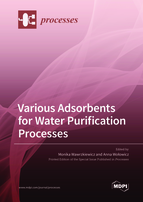Various Adsorbents for Water Purification Processes
A special issue of Processes (ISSN 2227-9717). This special issue belongs to the section "Environmental and Green Processes".
Deadline for manuscript submissions: closed (30 April 2021) | Viewed by 54813
Special Issue Editors
Interests: sorption and separation of inorganic (heavy metal ions) and organic compounds (dyes, phenols); textile wastewaters treatment; chemical modification of synthetic and natural polymers as adsorbents for water treatment; hybrid materials; low-cost adsorbents; anion-exchange resins; synthetic oxide materials; photochemistry; environmental protection
Special Issues, Collections and Topics in MDPI journals
Interests: sorption and separation of inorganic and organic compounds e.g., heavy metal ions, dyes, phenols; textile wastewaters treatment; ion-exchange resins; synthetic oxide materials; hybrid materials; low-cost adsorbents; environmental protection
Special Issues, Collections and Topics in MDPI journals
Special Issue Information
Dear Colleagues,
Currently, one of the main problems of global importance is the increasing amount of pollution generated into the environment due to the intensive development of industry, the use of its goods and active human activity. Particular attention is paid to those industries that consume considerable amounts of water in technological processes and thus generate significant amounts of wastewater containing harmful and toxic substances posing an immediate threat to the health and life of living organisms, including humans. Heavy metal ions, metalloids and various types of organic compounds such as dyes, pesticides, surfactants, phenols, WWA and many others are particularly dangerous. Therefore, there is a need to remove them and monitor their concentration in the environment so that the permissible standards are not exceeded and in order to avoid legal consequences.
Adsorption or its combination with other techniques enables effective removal, sorption and separation of organic and inorganic impurities using various types of materials, i.e. functionalized and non-functionalized polymeric resins, carbon type sorbents, natural and synthetic oxide materials, clay minerals and zeolites, biopolymers, biomass, low-cost adsorbents, composite and hybrid ones. Therefore, attempts to search for effective adsorbents and assess their adsorption properties play an important role from a cognitive and application point of view.
The special issue Various Adsorbents for Water Purification Processes aims at publishing experimental and review papers as well as short communications discussing the recent developments in the field of synthesis, modification, physicochemical characteristics and evaluation of adsorption properties of different materials to obtain adsorbents for applications in water and wastewater treatment and purification processes. The topics of the papers to be submitted to this Special Issue are defined, but not limited, by the keywords presented below.
Dr. Monika Wawrzkiewicz
Dr. Anna Wołowicz
Guest Editors
Manuscript Submission Information
Manuscripts should be submitted online at www.mdpi.com by registering and logging in to this website. Once you are registered, click here to go to the submission form. Manuscripts can be submitted until the deadline. All submissions that pass pre-check are peer-reviewed. Accepted papers will be published continuously in the journal (as soon as accepted) and will be listed together on the special issue website. Research articles, review articles as well as short communications are invited. For planned papers, a title and short abstract (about 100 words) can be sent to the Editorial Office for announcement on this website.
Submitted manuscripts should not have been published previously, nor be under consideration for publication elsewhere (except conference proceedings papers). All manuscripts are thoroughly refereed through a single-blind peer-review process. A guide for authors and other relevant information for submission of manuscripts is available on the Instructions for Authors page. Processes is an international peer-reviewed open access monthly journal published by MDPI.
Please visit the Instructions for Authors page before submitting a manuscript. The Article Processing Charge (APC) for publication in this open access journal is 2400 CHF (Swiss Francs). Submitted papers should be well formatted and use good English. Authors may use MDPI's English editing service prior to publication or during author revisions.
Keywords
- adsorbents
- adsorption
- environment
- wastewaters
- heavy metals
- toxic substances
- purification
- removal







